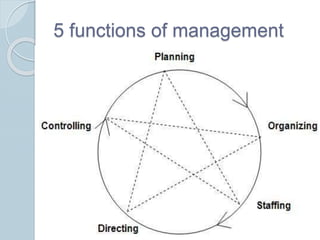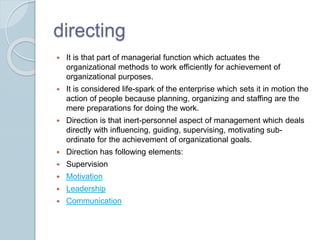549745354-Functions-of-Management-presentation-ppt.pptx
- 2. Definition of management ’éŚ According to Henry Fayol, ŌĆ£To manage is to forecast and plan, to organize, to command, & to controlŌĆØ. ’éŚ Whereas Luther Gullick has given a keyword ŌĆÖPOSDCORBŌĆÖ where P stands for Planning, O for Organizing, S for Staffing, D for Directing, Co for Co-ordination, R for reporting & B for Budgeting. ’éŚ But the most widely accepted are functions of management given by KOONTZ and OŌĆÖDONNEL i.e. Planning, Organizing, Staffing, Directing and Controlling.
- 3. 5 functions of management
- 4. planning ’éŚ It is the basic function of management. ’éŚ It deals with chalking out a future course of action & deciding in advance the most appropriate course of actions for achievement of pre-determined goals. ’éŚ According to KOONTZ, ŌĆ£Planning is deciding in advance - what to do, when to do & how to do. ’éŚ It bridges the gap from where we are & where we want to beŌĆØ. A plan is a future course of actions. ’éŚ It is an exercise in problem solving & decision making. ’éŚ Planning is determination of courses of action to achieve desired goals. Thus, planning is a systematic thinking about ways & means for accomplishment of pre-determined goals. ’éŚ Planning is necessary to ensure proper utilization of human & non- human resources. ’éŚ It is all pervasive, it is an intellectual activity and it also helps in avoiding confusion, uncertainties, risks, wastages etc.
- 5. oeganizing ’éŚ It is the process of bringing together physical, financial and human resources and developing productive relationship amongst them for achievement of organizational goals. ’éŚ According to Henry Fayol, ŌĆ£To organize a business is to provide it with everything useful or its functioning i.e. raw material, tools, capital and personnelŌĆÖsŌĆØ. ’éŚ To organize a business involves determining & providing human and non-human resources to the organizational structure. Organizing as a process involves: ŌŚ” Identification of activities. ŌŚ” Classification of grouping of activities. ŌŚ” Assignment of duties. ŌŚ” Delegation of authority and creation of responsibility. ŌŚ” Coordinating authority and responsibility relationships.
- 6. staffing ’éŚ It is the function of manning the organization structure and keeping it manned. ’éŚ Staffing has assumed greater importance in the recent years due to advancement of technology, increase in size of business, complexity of human behavior etc. ’éŚ The main purpose o staffing is to put right man on right job i.e. square pegs in square holes and round pegs in round holes. ’éŚ According to Kootz & OŌĆÖDonell, ŌĆ£Managerial function of staffing involves manning the organization structure through proper and effective selection, appraisal & development of personnel to fill the roles designed un the structureŌĆØ. Staffing involves: ŌŚ” Manpower Planning ŌŚ” Recruitment, Selection & Placement. ŌŚ” Training & Development. ŌŚ” Remuneration. ŌŚ” Performance Appraisal. ŌŚ” Promotions & Transfer.
- 7. directing ’éŚ It is that part of managerial function which actuates the organizational methods to work efficiently for achievement of organizational purposes. ’éŚ It is considered life-spark of the enterprise which sets it in motion the action of people because planning, organizing and staffing are the mere preparations for doing the work. ’éŚ Direction is that inert-personnel aspect of management which deals directly with influencing, guiding, supervising, motivating sub- ordinate for the achievement of organizational goals. ’éŚ Direction has following elements: ’éŚ Supervision ’éŚ Motivation ’éŚ Leadership ’éŚ Communication
- 8. Part of directing ’éŚ Supervision- implies overseeing the work of subordinates by their superiors. It is the act of watching & directing work & workers. ’éŚ Motivation- means inspiring, stimulating or encouraging the sub- ordinates with zeal to work. Positive, negative, monetary, non- monetary incentives may be used for this purpose. ’éŚ Leadership- may be defined as a process by which manager guides and influences the work of subordinates in desired direction. ’éŚ Communications- is the process of passing information, experience, opinion etc from one person to another. It is a bridge of understanding.
- 9. controlling ’éŚ It implies measurement of accomplishment against the standards and correction of deviation if any to ensure achievement of organizational goals. ’éŚ According to Koontz & OŌĆÖDonell ŌĆ£Controlling is the measurement & correction of performance activities of subordinates in order to make sure that the enterprise objectives and plans desired to obtain them as being accomplishedŌĆØ. ’éŚ Therefore controlling has following steps: ŌŚ” Establishment of standard performance. ŌŚ” Measurement of actual performance. ŌŚ” Comparison of actual performance with the standards and finding out deviation if any. ŌŚ” Corrective action.









